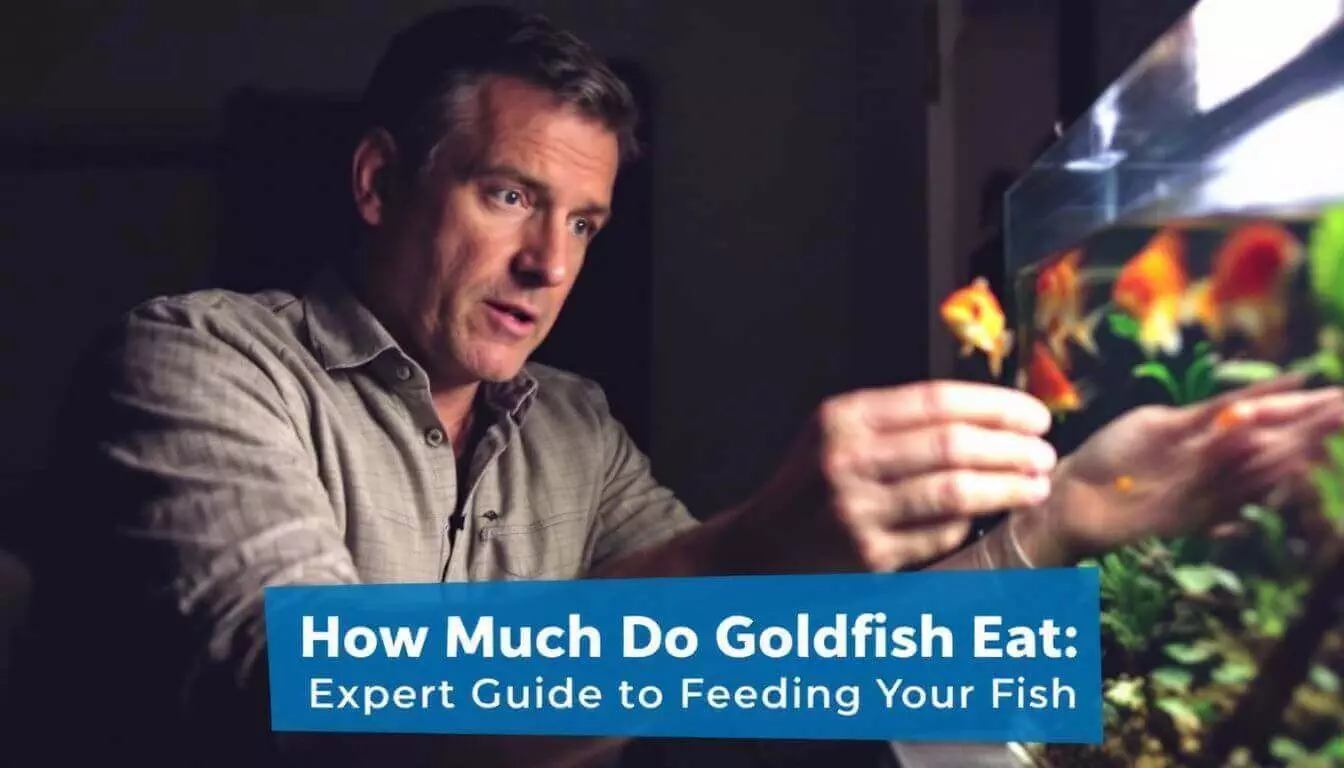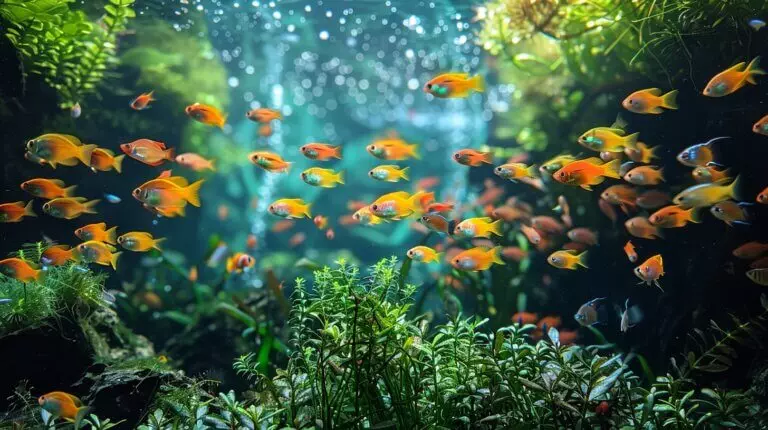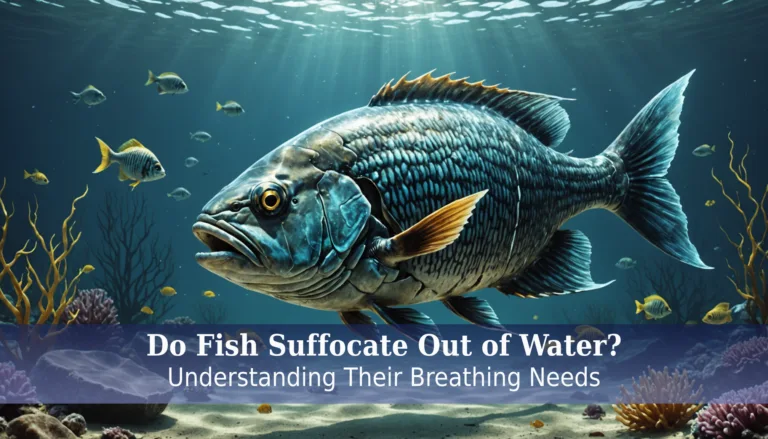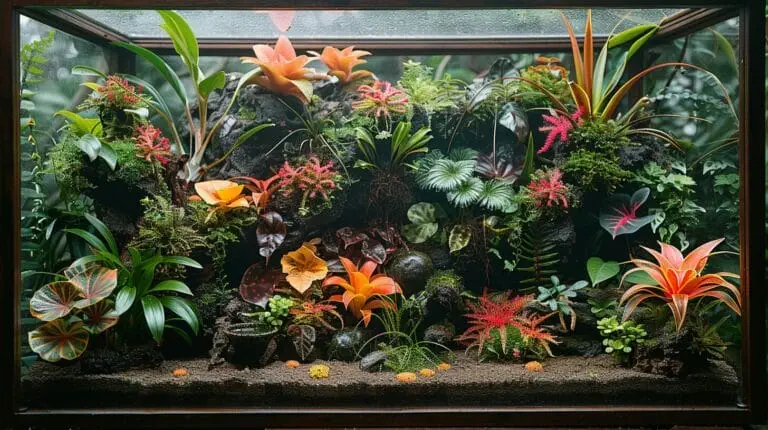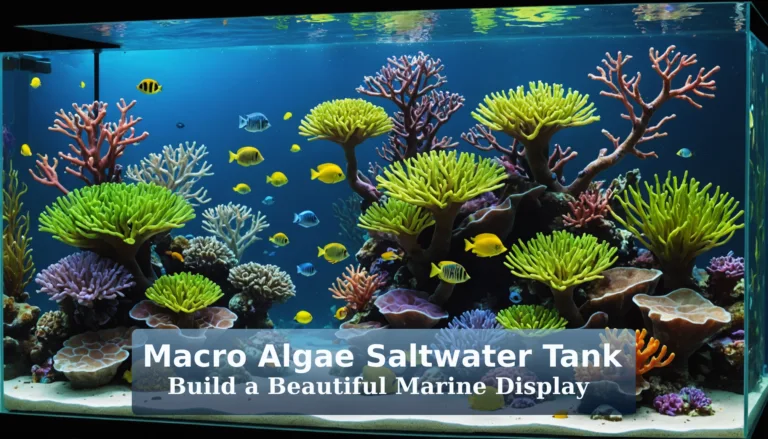Goldfish don’t have stomachs like humans do. 2 This means they digest food differently. Many people overfeed their goldfish, which can harm them. How much do goldfish eat? The answer varies based on their size and type. 3
I’ve kept goldfish for over 10 years. I’ve learned the right ways to feed them through trial and error. In this guide, you’ll discover the best feeding practices for healthy, happy goldfish.
Get ready to become a goldfish feeding expert. 1
Key Takeaways
- Goldfish need 30% to 40% protein in their food and should eat a mix of dry pellets, fresh veggies, and frozen treats.
- Feed adult goldfish once a day, and young goldfish 2 to 3 small meals daily. Skip one day of feeding per week.
- Choose pellet sizes that match your goldfish’s eye size. Soak dry food for 5 to 10 seconds before feeding.
- Remove uneaten food after 2 to 5 minutes to keep the tank clean and prevent overfeeding.
- Adjust feeding based on seasons. Feed less in winter when fish are less active and digest food more slowly.
Understanding Goldfish Dietary Needs

Goldfish need a balanced diet to thrive. Their food must have the right mix of proteins, fats, and carbs.
Natural Feeding Habits: What Do Goldfish Eat?
Goldfish are opportunistic eaters in the wild. They munch on plants, insects, and small crustaceans. Your pet goldfish will happily gobble up almost anything you offer. In aquariums, they thrive on a mix of plant matter and protein-rich foods.
Live plants like elodea provide fiber and mimic their natural diet. Frozen foods such as bloodworms and brine shrimp offer essential nutrients. 1
Goldfish are nature’s little garbage disposals. They’ll eat just about anything that fits in their mouths! – Experienced Aquarist
Green veggies are great for goldfish health. Try feeding them blanched broccoli, spinach, or courgette. These foods help with digestion and provide vital nutrients. For a balanced diet, mix dry flakes or pellets with fresh and frozen options.
This variety ensures your goldfish get all the nutrients they need to stay healthy and active.
Nutritional Requirements for Healthy Goldfish
Moving from what goldfish eat in nature, let’s focus on their nutritional needs in captivity. Healthy goldfish require a balanced diet with specific nutrients. You need to provide food low in protein and high in plant matter.
Your goldfish’s food should contain 30% to 40% protein. Too much protein can harm their digestive systems. Pick sinking pellets from brands like Tetra or Hikari. Soak dry food for 5 to 10 seconds before feeding.
Give frozen food twice a week as a treat. Avoid foods with additives or fish by-products. These steps ensure your goldfish get the right nutrients for health and growth.
Factors Affecting How Much Goldfish Eat
Goldfish size plays a big role in how much they eat. Bigger fish need more food than smaller ones. A fancy goldfish might eat more than a regular one. The tank’s water temp also matters. Cooler water slows down a goldfish’s digestion. This means they eat less in colder months. 4
Fish activity levels affect their hunger too. Active goldfish burn more energy and need more food. Stress can make them eat less. Good water quality helps keep their appetite up. Watching how much waste your fish make can tell you if you’re feeding right.
Let’s look at how to figure out the right amount to feed your goldfish.
How Much Do Goldfish Eat: Determining the Right Amount
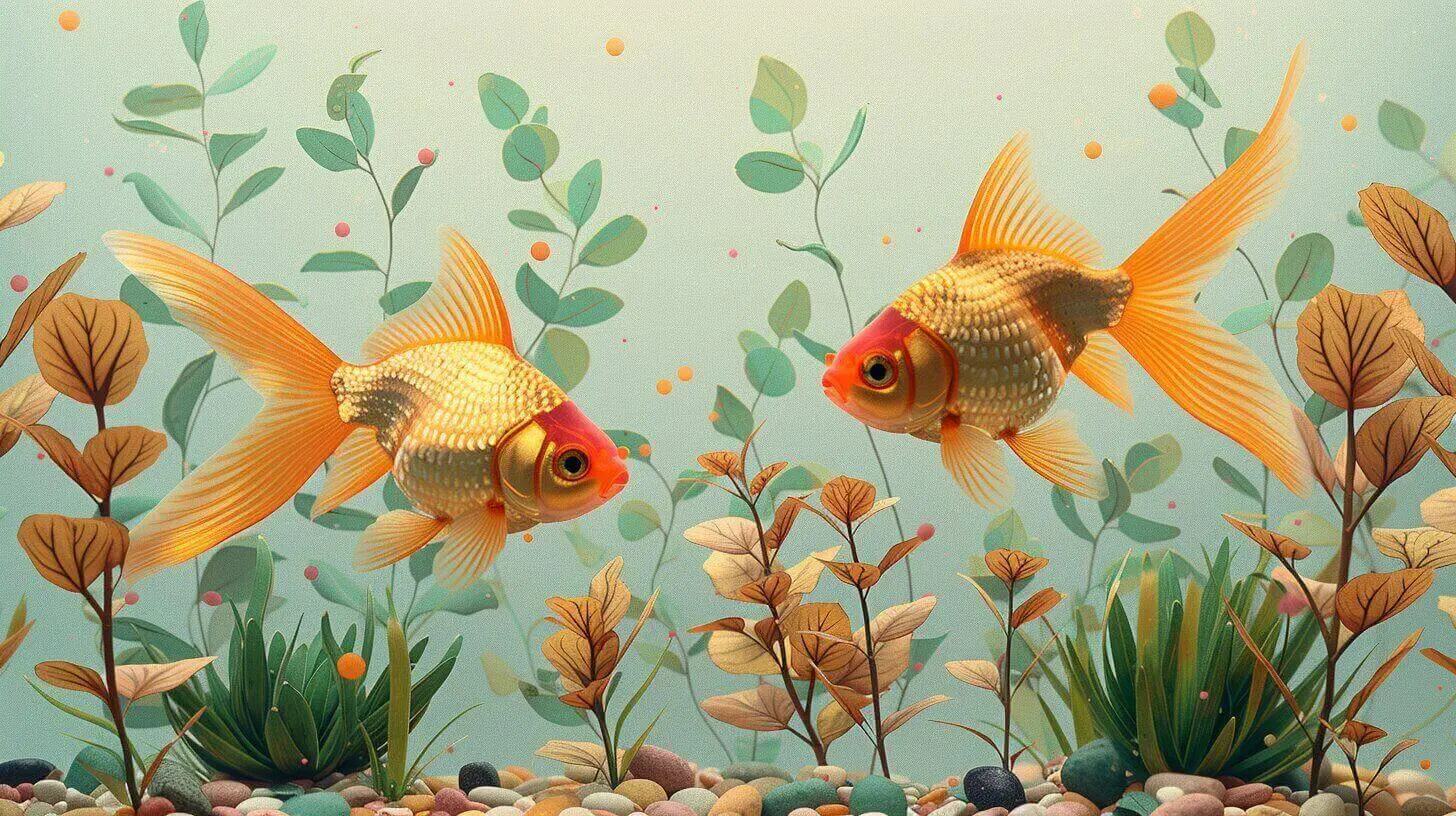
Feeding your goldfish the right amount is key to their health. You’ll need to consider your fish’s size, age, and activity level to get it just right.
Calculating Portion Sizes for Different Goldfish Sizes
Goldfish need the right amount of food to stay healthy. Here’s how to figure out portion sizes for different goldfish sizes:
- Tiny goldfish (up to 1 inch):
- Feed 2 to 3 tiny pellets twice a dayUse pellets smaller than the fish’s eye
- Small goldfish (1-2 inches):
- Offer 3 to 4 small pellets twice dailyChoose pellets about the size of the fish’s eye
- Medium goldfish (2-4 inches):
- Give 4 to 5 medium pellets twice a dayPick pellets slightly larger than the fish’s eye
- Large goldfish (4-6 inches):
- Provide 5 to 6 large pellets twice dailyUse pellets about 1.5 times the size of the fish’s eye
- Extra-large goldfish (6+ inches):
- Feed 6 to 8 extra-large pellets twice a daySelect pellets twice the size of the fish’s eye
- Fancy goldfish:
- Reduce portions by 25% due to smaller bodies
- Feed smaller pellets to avoid digestive issues
- Singletail goldfish:
- Increase portions by 10% for their longer bodies
- Offer a mix of pellet sizes for variety
- Adjust for activity level:
- Active fish may need 10% more food
- Less active fish may need 10% less food
- Consider water temperature:
- Warmer water (above 70°F) may require 5% more food
- Cooler water (below 60°F) may need 5% less food
- Use the “2-minute rule”:
- Feed only what your fish can eat in 2 minutes
- Remove uneaten food after this time. 3
Frequency: How Often to Feed Your Goldfish
Feeding your goldfish the right amount at the right times keeps them healthy. Here’s a guide to help you set up a good feeding schedule:
- Feed adult goldfish once a day. This routine matches their natural eating habits and digestion. 5
- Give young goldfish 2 to 3 small meals daily. Their fast growth needs more frequent feedings.
- Offer food at the same times each day. This helps your fish know when to expect meals.
- Skip one day of feeding per week. This mimics fasting periods in nature and aids digestion.
- Adjust feeding based on water temp. Feed less in cooler water as fish digest slower.
- Watch for signs of hunger like begging at the top of the tank. This may mean you need to feed more.
- Remove uneaten food within 2 to 5 minutes. This keeps your tank clean and prevents overfeeding.
- Use a feeding ring to contain food in one spot. This makes cleanup easier and stops food waste.
Signs of Overfeeding and Underfeeding Goldfish
Goldfish need the right amount of food to stay healthy. Watch for these signs to know if you’re feeding them too much or too little:
- Bloated belly: Overfed goldfish look puffy and round. 6
- Excess waste: Too much food leads to more poop in the tank. 6
- Cloudy water: Uneaten food dirties the water fast.
- Lethargy: Underfed fish move slowly and lack energy.
- Weight loss: Fish that don’t eat enough get thin.
- Pale color: Not enough food can make goldfish lose their bright hue.
- Begging for food: Hungry fish may swim to the top when you approach.
- Picking at plants: Underfed goldfish might eat tank plants out of hunger.
- Aggression: Fish may fight over food if there’s not enough.
- Floating issues: Overfed fish can have trouble swimming normally.
Now let’s look at the types of food that work best for goldfish.
Types of Food to Feed Goldfish

Goldfish need a mix of dry and fresh foods to stay healthy. You can feed them pellets, flakes, and live treats like daphnia or brine shrimp. Want to learn more about the best foods for your goldfish? Keep reading!
Choosing the Right Pellet Size for Your Goldfish
Pick the right pellet size for your goldfish. Small pellets work best for most goldfish. They’re easy to eat and digest. Fancy goldfish need even tinier pellets. Their round bodies make eating harder.
Soak dry food before feeding. Put pellets in tank water for 5 to 10 seconds. This softens them up. Your goldfish can now eat without trouble. Soaking also stops air from getting in their stomachs. This keeps your fish healthy and happy. 2
Balancing Dry and Fresh Food in Goldfish Diet
After picking the right pellet size, you need to mix dry and fresh foods. Your goldfish need both for a full diet. Dry foods like flakes and pellets are easy to use. They have many nutrients.
But they can cause air gulping if they float. Fresh foods give extra benefits. Veggies like zucchini, peas, and spinach help digestion. They also add fiber to the diet.
A good mix is 75% dry food and 25% fresh food. Feed dry food daily. Give fresh food 2 to 3 times a week. Gel foods, such as Repashy Super Gold, are great too. They’re easy for goldfish to digest.
Don’t forget, goldfish eat plants and algae in the tank. This helps keep the tank clean.
Supplements and Treats: When and How to Use Them
Supplements and treats add variety to your goldfish’s diet. Use them wisely to boost health and happiness.
- Offer veggies like lettuce or spinach 2 to 3 times weekly 2
- Feed live foods such as brine shrimp for extra protein 2
- Give treats in small amounts – no more than 10% of diet
- Try gel foods with added vitamins for picky eaters
- Avoid human foods like bread or cheese – they can harm fish
- Use garlic-enhanced foods to boost immunity in sick fish
- Rotate treat types to prevent boredom and ensure balanced nutrition
- Feed color-enhancing foods sparingly to brighten fish hues
Proper Techniques to Feed Goldfish in Your Tank

Feeding your goldfish right keeps them happy and healthy. Learn how to give them the perfect meal in any tank size.
Best Practices for Feeding Goldfish in Different Tank Sizes
Tank size affects how you feed your goldfish. Here are key tips for different setups:
- Small tanks (5-10 gallons): Feed tiny amounts 2 to 3 times daily. Use a pinch of flakes or 2 to 3 small pellets per fish.
- Medium tanks (20-30 gallons): Offer slightly larger portions 2 times a day. Give each fish 3 to 4 medium pellets or a small pinch of flakes. Spread food across the tank surface for even eating.
- Large tanks (50+ gallons): Feed 1 to 2 times daily with more variety. Mix dry and fresh foods like bloodworms or veggies. Use floating rings to contain food in one spot.
- Ponds: Feed 2 to 3 times daily in warm months. Toss in sinking pellets near the edges. Cut back to once daily or less in winter as fish slow down.
- Overstock tanks: Cut portions by 25% and feed more often. This helps all fish get enough without fouling the water.
How to Distribute Food Evenly in the Tank
Feeding your goldfish evenly is key to their health. Here’s how to spread food in your tank:
- Use both floating and sinking food. This helps all fish get their share. 2
- Sprinkle food across the water’s surface. Don’t dump it in one spot.
- Drop sinking pellets in different areas. This lets bottom-feeders eat too.
- Watch your fish as they eat. Make sure each one gets food.
- Feed small amounts often. It’s better than one big meal.
- Try a feeding ring. It keeps food in one area for easy eating.
- Use a turkey baster to target feed. Great for shy fish.
- Rotate feeding spots daily. This stops one fish from claiming territory.
- Break up large flakes. Smaller bits spread more evenly.
- Turn off filters during meals. Food won’t get sucked away.
Cleaning Up After Feeding: Maintaining Water Quality
Keep your goldfish tank clean after meals. Remove uneaten food within 2 to 5 minutes. This stops extra food from rotting and hurting water quality. Do weekly water tests to check pH and ammonia levels.
Change some water often to cut down harmful stuff. Clean filters and decorations in tank water only. This saves good bacteria that help your fish stay healthy.
Use a small net or turkey baster to scoop out leftover bits. Vacuum the gravel to pick up sunken food particles. Wipe algae off glass with a soft cloth. These steps keep your tank fresh and your goldfish happy. Good habits make tank care easier and more fun for you.
Common Goldfish Feeding Mistakes and How to Avoid Them
Feeding goldfish can be tricky. You might make mistakes that hurt your fish. Let’s look at common errors and how to fix them.
The Dangers of Overfeeding Your Goldfish
Overfeeding goldfish can lead to serious health issues. Excess food pollutes the tank, causing poor water quality. This stresses your fish and can make them sick. Uneaten food in the bowl is a clear sign you’re giving too much. 7
High ammonia levels from leftover food harm goldfish. This can cause fin rot, breathing problems, and even death. Stick to feeding small amounts. Remove any food left after 2 minutes.
Next, let’s look at how to handle picky eaters among your goldfish.
Addressing Picky Eating Habits in Goldfish
Goldfish can be picky eaters. Some refuse different foods. Don’t give up if your goldfish is fussy.
Try new foods often. Mix things up with different pellets, flakes, and fresh options. Keep portions small to avoid waste. Watch your fish closely to see what they like best.
You can tempt picky goldfish with tasty treats. Freeze-dried foods often work well. Live foods like brine shrimp or daphnia may spark interest too.
Offer veggies like blanched spinach or zucchini. Clip these to the tank side for easy nibbling. Be patient and keep trying. Your goldfish’s tastes may change over time.
Seasonal Adjustments to Goldfish Feeding Routines
Goldfish need less food in cold months. Their body temp drops, slowing digestion. Cut back on meals as winter nears. In summer, they may eat more. Watch your fish closely. Adjust food amounts based on their activity.
This keeps them healthy year-round. Use a good quality flake food or pellets as their main diet. 2 Add fresh veggies like lettuce or peas for extra nutrients. Clean up any leftover food to keep the tank water clean.
Conclusion
Feeding your goldfish right keeps them happy and healthy. You now know how much to feed, when to feed, and what to feed. Watch for signs of over or underfeeding. Adjust your routine as needed.
With these tips, you’ll raise thriving goldfish in no time.
FAQs
1. How much should I feed my goldfish?
Feed your goldfish small bits of food 2 to 4 times a week. Don’t give too much. A tiny pinch is enough.
2. What’s a good diet for goldfish?
Goldfish are omnivores. They need both plant and animal food. Use a mix of tropical fish food, veggies, and live treats like brine shrimps.
3. Can goldfish eat human food?
Yes, but be careful. Boil veggies first. Use a strainer to remove extra water. Give small amounts of peas, cucumber, or lettuce.
4. How do I know if my goldfish is getting enough food?
Look at your fish’s belly. It should be slightly round, not flat or too big. If it looks concave, feed a bit more.
5. Why is my goldfish always hungry?
Goldfish will eat a lot if given the chance. But they don’t need much food. Don’t worry if they seem hungry. It’s normal.
6. How does water temp affect how much goldfish eat?
Goldfish are cold-blooded. In warm water, they eat more. In cool water, they eat less. Check your tank’s temp to know how much to feed.
References
- ^ https://www.amazon.com/What-Do-Goldfish-Eat-Everything-ebook/dp/B0D88GT746
- ^ https://injaf.org/aquarium-fish/the-goldfish-section/goldfish-and-their-diet/
- ^ https://www.fishlore.com/aquariumfishforum/threads/how-much-should-i-feed-my-goldfish.60750/
- ^ https://www.aquariumadvice.com/threads/how-much-to-feed-to-my-goldfish-flakes-and-pellets.382268/ (2024-03-20)
- ^ https://kb.rspca.org.au/knowledge-base/how-should-i-care-for-my-goldfish/
- ^ https://www.fishlore.com/aquariumfishforum/threads/over-feeding-vs-underfeeding-how-do-i-know.168051/ (2014-04-12)
- ^ https://be.chewy.com/3-common-mistakes-goldfish-care/ (2021-01-20)

